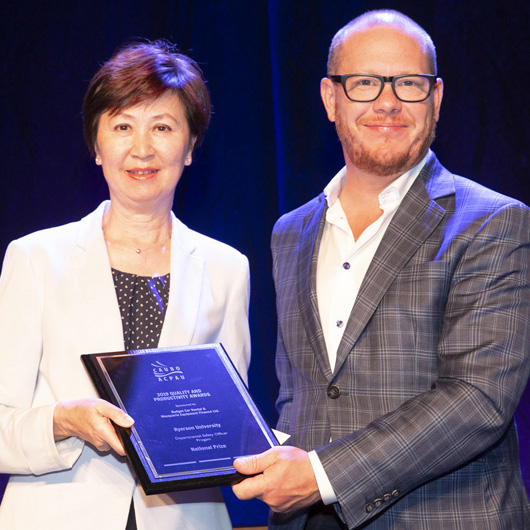Key Highlights in 2019

In 2019, Ryerson has demonstrated commitment in providing a safe and healthy environment for work and study. Working across the university, EHS has collaborated to maintain safety training, workplace inspections, incident investigation and response, respond to communicable disease cases and develop safety programs to protect faculty, staff and students.


Safety training
Safety training for both students and employees helps ingrain safety into our work and learning culture. The university offers safety training in various forms, such as in-person classes, e-learning and online videos.

Mandatory eLearning courses
There are two safety-related eLearning courses that all employees at Ryerson are required to complete:
- Environmental Health and Safety (EHS) eLearning
- Workplace Hazardous Materials Information System (WHMIS) Awareness eLearning
The WHMIS training is also mandatory for students that work with hazardous materials.
In 2019:
- 2037 employees completed the EHS eLearning
- 1916 employees completed the WHMIS eLearning
- 1740 students completed the WHMIS eLearning
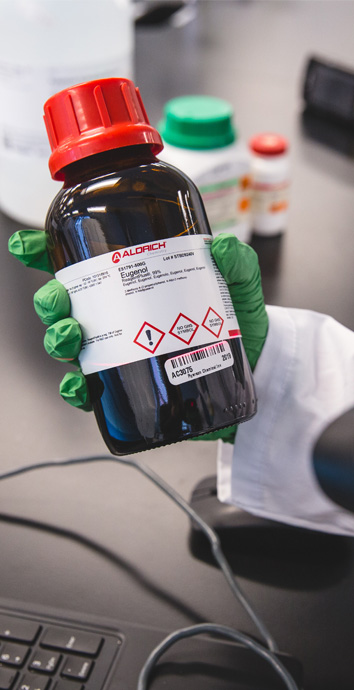
5,693 employees and students completed mandatory eLearning courses in 2019.
In-class safety training in 2019
In 2019, the EHS team offered almost 50 in-class safety-training sessions to over 1700 employees. New sessions this year included:
- Contractor Orientation and Racking Safety
- Advanced Emergency Spills Response training
The Advanced Emergency Spills Response training was provided by an external emergency response professional. Training was offered to EHS staff, technicians and departmental safety officers in chemistry and engineering wet labs.

In 2019, the EHS team offered almost 50 in-class safety-training sessions to over 1700 employees.
Participants shown in the chart include employees and students, but the majority was largely employees.
*New Training in 2019
This chart highlights the number of participants in various in-class safety training sesions in 2018 and 2019. The two largest courses in 2019 were Health and Safety for first-year Engineering Undergrads with 1204 particpants, followed by Biosafety training with 105 participants. The two largest courses in 2018 were Biosafety with 101 particpants, followed by Fire Extinguisher Training with almost 80 participants.
| Training | Number of participants 2018 | Number of participants 2019 |
| Biosafety | 101 | 105 |
| Chemical & Lab Safety Program (WHMIS 2015 drop in session) | 15 | 10 |
| Daphne Cockwell Complex orientation training* | N/A | 34 |
| Fire Warden | 0 (every other year) | 73 |
| Fire Extinguisher | 78 | 63 |
| Health and Safety for Managers & Supervisors | 3 | 5 |
| Laser Safety | 33 | 34 |
| Contractor Orientation Training* | N/A | 13 |
| Office Ergonomics | 13 | 14 |
| Radiation Safety | 2 | 27 |
| Scissor Lift (for specific departments) | 29 | 17 |
| Student Worker’s Safety | 21 | 30 |
| Transportation of Dangerous Goods (TDG) - Biological TDG 6.2 | 7 | 10 |
| TDG (Full all hazard classes) | 0 | 7 |
| Health and Safety for first-year Engineering Undergrads | 1101 | 1204 |
| Emergency Spill response* | N/A | 12 |
| X-ray Safety | 14 | 10 |
| Lockout Tagout Training | N/A | 22 |
| Racking Safety* | N/A | 9 |
| Working at Heights | 34 | 100 |
*New Training in 2019
Online training
For students, online training sessions were well received. In 2019, 4,604 students participated in online training.
Participants shown in the chart include employees and students, but the majority was largely students.

In 2019, 4,604 students participated in online training.
Participants shown in the chart include employees and students, but the majority was largely students.
This chart highlights the number of participants in various online safety training sesions. The top courses in 2019 were EHS Awareness for Employees with 2037 particpants, followed by WHIMIS for employees with 1916 participants.
| Online training | Number of participants in 2018 | Number of participants in 2019 |
| WHMIS (students) | 1617 | 1740 |
| WHMIS (employees) | 2376 | 1916 |
| Biosafety Awareness | 784 | 1152 |
| Chemical Safety | 362 | 119 |
| EHS placement | 1507 | 1430 |
| EHS Awareness for Employees (mandatory) | 2635 | 2037 |
| Compressed Gas Awareness | 95 | 110 |
| Machine Safety | 125 | 53 |

Joint Health and Safety Committee

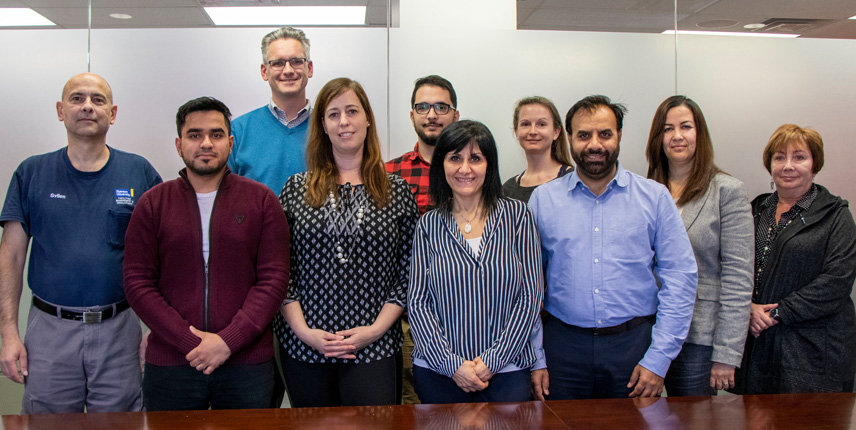
Ryerson’s Joint Health and Safety Committee (JHSC) includes both union and management members and makes recommendations to advance workplace safety within the organization.
Front row left to Right: Zahid Patel, Amanda Barber, Silvana Babikian, Muhammad Yousaf.
Back row left to right: Svilen Stoyanov (co-chair), Darrick Heyd (co-chair), Malek El-Aooiti, Melanie Loiselle, Habiba Bougherara, Laurie Jacklin
In 2019, the JHSC maintained regular meetings as required under the Ontario Health and Safety Act. It was consulted in the development of new safety policies and programs. It was also notified of workplace testing and received reports concerning occupational health and safety.
In 2019 the JHSC has also collaborated with EHS to develop a comprehensive workplace inspection strategy. The strategy has been implemented and details are provided in the Major Highlights - Workplace Inspection section.
Committee representatives
Co-chairs
- Darrick Heyd
- Svilen Stoyanov
Management representatives
- Kate Reade
- Ken Ozdemir
- Silvana Babikian
Worker representatives
- Habiba Bougherara
- Dejan Ninkovic
- Muhammad Yousaf
- Malek El-Aooiti
The Joint Health and Safety Committee includes both union and management members and makes recommendations to advance workplace safety.

Program and policy development in 2019
Animals on Campus Policy
A working group was developed to revise Ryerson’s existing policy on animals on campus. The policy supports the commitment to the accommodation of persons with disabilities through the presence of Service Animals or Therapeutic/Emotional Support Animals, as required by the Ontario Human Rights Code and the Accessibility for Ontarians with Disabilities Act.
The revised policy includes:
- a more collaborative framework outlining departmental roles and responsibilities,
- a risk assessment process for animals that have the potential to pose risks to health and safety and/or require access to high-risk areas.
Animals intended for use in teaching, research or creative activities, are referenced in this policy but follow a separate approved protocol by the University’s Animal Care Committee.
The policy is in the last stages of approval and will replace the existing policy.

Ryerson’s revised policy supports the commitment to the accommodation of persons with disabilities.

Physical Workplace Inspections and Tracking System
In 2019, a new partnership was formed between the JHSC, EHS, departmental safety officers and the Facilities Management and Development maintenance and operations team for workplace inspections and hazard resolution.
More information on the partnership’s activities and next steps can be found in the Workplace Inspections, Audits & Assessments section.


Working Alone or in Isolation

While working alone or in isolation is not always hazardous, it can present risks due to the nature of work and has the potential to affect the health and safety of those involved.
In 2019, Ryerson’s Working Alone or in Isolation program was formalized. It outlines:
- roles and responsibilities,
- high risk activities in which working alone is prohibited,
- working alone risk assessment methodology,
- a risk assessment template, and
- a safety plan template.
In 2019, Ryerson formalized its Working Alone or in Isolation protocol.

Field Studies Program

While conducting field studies off-campus has many advantages, some types of field work may come with hazards and risks.
In 2019, EHS developed a Field Studies Program in collaboration and consultation with key stakeholders such as Ryerson International, the Faculty of Science and the Faculty of Arts.

The program includes a risk-assessment tool that can be completed prior to the start of an activity. It assists participants in classifying field studies as low, medium, high or extreme risk and determining if an associated activity plan is required.

A Safety Provision Checklist is also available to help participants determine the key safety provisions required in the event of an injury or emergency when conducting an off-campus field study.

Smoking and Vaping on Campus
In consultation with stakeholders, in 2019, EHS coordinated the development of the Smoking and Vaping on Campus policy. The new policy is designed to comply with Ontario’s smoke-free legislation to minimize unwanted exposure to tobacco, cannabis or nicotine vapours (including vaping).
The policy prohibits smoking and vaping:
- in or on any university property that is an enclosed public place or enclosed workplace;
- in any university property that is a vehicle;
- within 9 meters of university property building entrances, exits, loading docks, fresh air intakes, and compressed gas storage areas;
- within 20 meters of university property that is a children’s playground or child-care center; or
- in the university Quad.
The policy includes exemptions for those specific activities used for research purposes and accommodating persons consuming medical cannabis.
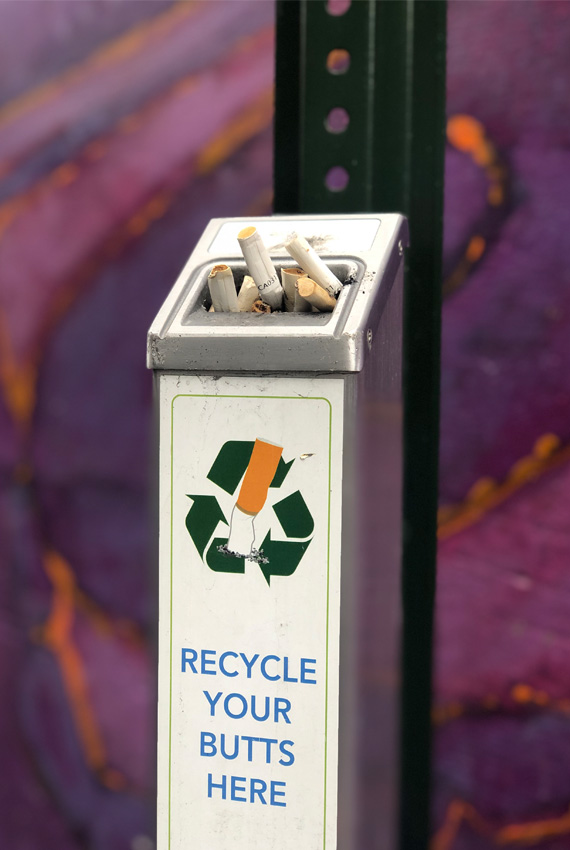

Designated Substance Assessment

In 2019, EHS conducted a two-phased designated substances assessment to identify all designated substance use on campus and to implement potential designated substances control programs.
Designated substances are defined under the Occupational Health and Safety Act as “a biological, chemical or physical agent or combination thereof prescribed as a designated substance to which the exposure of a worker is prohibited, regulated, restricted, limited or controlled.”
The first phase identified key work activities with designated substances at the university and involved a full assessment based on potential exposures to the substance.
The assessment found that:
- the current use of designated substances on campus is very low and infrequent,
- the activities include adequate control measures (such as the use of fume hoods and other engineering controls, administrative controls and the use of personal protective equipment), and
- that no worker or student is at risk of exposure to designated substances.
No additional control programs were required.
The assessment found that the current use of designated substances on campus is very low and infrequent.
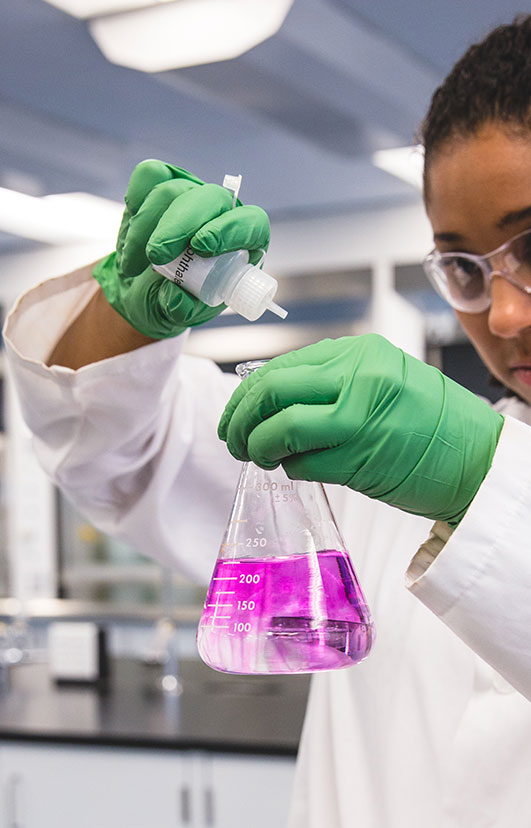

Shipping, Receiving and Mail Services Safety Initiatives
In 2019, in partnership with EHS, Shipping, Receiving and Mail Services launched a health and safety initiative. The goal was to reduce potential incidents and injuries, as they work in high-traffic areas, and to improve pedestrian safety for the Ryerson community.
The project kicked off with a review of existing processes and procedures, and hazard assessments.
In 2020, the focus will be on rolling out tools specific to shipping, receiving and mail services operations including a robust training and onboarding plan for new hires, and engineering and administrative controls to ensure pedestrian safety.
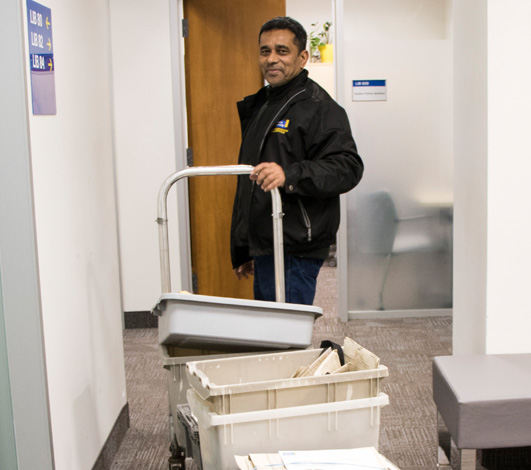

Public Health Threat Committee

In 2017, a committee was formed to respond to instances of suspected or confirmed public health communicable disease cases. In late 2018, the Public Health Threat committee formally established its terms of reference.
There are currently four members on the committee:
- executive director, student wellbeing
- director, environmental health and safety
- university biosafety officer, environmental health and safety
- faculty epidemiologist specializing in communicable disease.
Advisors for the committee include:
- members from the executive group,
- Ryerson International,
- administration and operations communications,
- human resources,
- legal and privacy,
- housing and residence,
- food services,
- facilities maintenance and operations,
- Office of the Registrar
The committee works under the direction of Toronto Public Health to quickly implement any actions and directives for active cases.

COVID-19 response
Ryerson’s Public Health Threats Committee was central to the university’s COVID-19 response. Working closely with the university’s Emergency Response Team, it monitored information from Toronto Public Health and other public health agencies daily, and made recommendations to the university’s leadership and executive committee. While the university is operating under an essential services model on campus at time of report publication, the committee is drafting and reviewing proposed protocols to help Ryerson with return-to-work planning.
In the year ahead, the committee will be able to debrief the university’s COVID-19 response. Working closely with the Emergency Response Team, the experience will allow Ryerson to strengthen strategies and protocols in response to communicable disease outbreaks. This planning will be done under the framework of the Emergency Management Plan.
Read more about the Public Health Threats Committee.
The committee works under the direction of Toronto Public Health to quickly implement any actions and directives for active cases.

Departmental Safety Officer (DSO) Committees

The DSO program facilitates compliance and injury prevention because it is based on an internal system for managing health and safety. The DSOs have a role in supporting and strengthening Ryerson’s environmental health and safety management system.
Toronto Metropolitan University has over 100 DSOs.
EHS supports the maintenance of the DSO program by participating on DSO committee meetings. In 2019, there were 38 DSO committee meetings. At these meetings, the DSOs, department chair or director and EHS manager discussed health and safety matters specific to each department.
The committee reviews reports of incidents/injuries and develops and implements action plans to control hazards and to resolve health and safety concerns.

DSO program recognition
In 2019, Ryerson’s Departmental Safety Officer (DSO) program was awarded a national Quality and Productivity Award (external link) from the Canadian Association of University Business Officers (CAUBO) in the category of “Recognizing Excellence in Risk Management”.
CAUBO awards recognize creativity, innovation and best practices in higher-education administration which improve the overall sustainability of the institution.
The award acknowledges the DSO program and DSO committees as an integral part of the environmental health and safety management system. The DSO committees have demonstrated an outstanding collaboration of the departmental chairs and non-academic directors, DSOs and EHS in addressing safety concerns and integrating safety into all aspects of work, learning and research activities.
